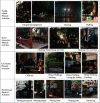Characteristics of Physical Activities and Environmental Factor Preferences of Older Adults in Rural Resettlement Community in Ningbo, China
- PMID: 36124242
- PMCID: PMC9482504
- DOI: 10.1155/2022/5414384
Characteristics of Physical Activities and Environmental Factor Preferences of Older Adults in Rural Resettlement Community in Ningbo, China
Abstract
As physical mobility declines, older adults become increasingly dependent on their living environment. The relationship between physical activities and community environments for older adults has been studied to help promote physical and mental health and increase social connections among older adults, thereby improving their quality of life and health status. This study analyzed the daily outdoor physical activities of older adults in Nanyu New Village, China, using behavior mapping and questionnaire research for data collection, and conducting a comprehensive analysis of the spatial, temporal, and environmental elements of the physical activities. This research showed that the physical activity choices of older adults in rural resettlement neighborhoods vary significantly by time, gender, and space. In decreasing order, surrounding support, site security, space convenience, beautiful landscape, and diverse facilities influence the outdoor physical activities of older adults. This study provides new insights into the ongoing debate on age-friendly communities and provides a useful reference for the design of age-friendly retrofitting of outdoor environments in rural resettlement communities.
Copyright © 2022 Shanshan Wu et al.
Conflict of interest statement
The authors declare that there are no conflicts of interest regarding the publication of this paper.
Figures










Similar articles
-
Do Age-Friendly Rural Communities Affect Quality of Life? A Comparison of Perceptions from Middle-Aged and Older Adults in China.Int J Environ Res Public Health. 2021 Jul 7;18(14):7283. doi: 10.3390/ijerph18147283. Int J Environ Res Public Health. 2021. PMID: 34299736 Free PMC article.
-
Identify the direct and indirect impacts of the community built environment on the health of older adults.Front Public Health. 2025 Mar 31;13:1478337. doi: 10.3389/fpubh.2025.1478337. eCollection 2025. Front Public Health. 2025. PMID: 40231175 Free PMC article.
-
A Space-Time Analysis of Rural Older People's Outdoor Mobility and Its Impact on Self-Rated Health: Evidence from a Taiwanese Rural Village.Int J Environ Res Public Health. 2021 May 31;18(11):5902. doi: 10.3390/ijerph18115902. Int J Environ Res Public Health. 2021. PMID: 34072884 Free PMC article.
-
Use of Connected Technologies to Assess Barriers and Stressors for Age and Disability-Friendly Communities.Front Public Health. 2021 Mar 11;9:578832. doi: 10.3389/fpubh.2021.578832. eCollection 2021. Front Public Health. 2021. PMID: 33777874 Free PMC article. Review.
-
Effects of environmental modification on activities of daily living, social participation and quality of life in the older adults: a meta-analysis of randomized controlled trials.Disabil Rehabil Assist Technol. 2020 Feb;15(2):132-140. doi: 10.1080/17483107.2018.1533595. Epub 2018 Nov 9. Disabil Rehabil Assist Technol. 2020. PMID: 30409070
Cited by
-
The goldilocks days represent optimal time-use to prevent obesity, low physical performance, risk and fear of falling in older adults.Sci Rep. 2025 Jul 9;15(1):24729. doi: 10.1038/s41598-025-09645-0. Sci Rep. 2025. PMID: 40634482 Free PMC article.
References
-
- National bureau of Statistics. Seventh National Population Census Bulletin. 2022. https://www.stats.gov.cn/tjsj/pcsj/rkpc/d7c/202111/P02021112652366736675... .
-
- Lianyi. How to build an age-friendly society. China Health . 2021;11:49–50.
-
- Yu Y., Zhu F., Jia S. Research on the assessment of age-friendly community. Shanghai Urban Planning Review . 2020;(06):1–6.
-
- Zhang J.-an. Approaches to building age-friendly community:A perspective from community capacity building theory. Journal of Northwest Normal University . 2021;58(6):107–119. doi: 10.16783/j.cnki.nwnus.2021.06.012. - DOI
-
- Zhou Y. Research on exterior environmental design with good social atmosphere of elderly-friendly communities: a case study of a community in beijing. Shanghai Urban Planning Review . 2020;6:15–21.
Publication types
MeSH terms
LinkOut - more resources
Full Text Sources
Medical
Research Materials

